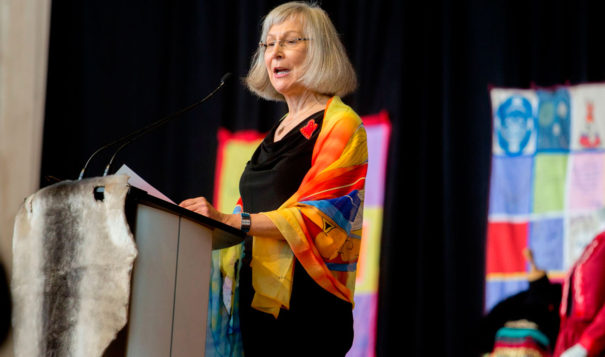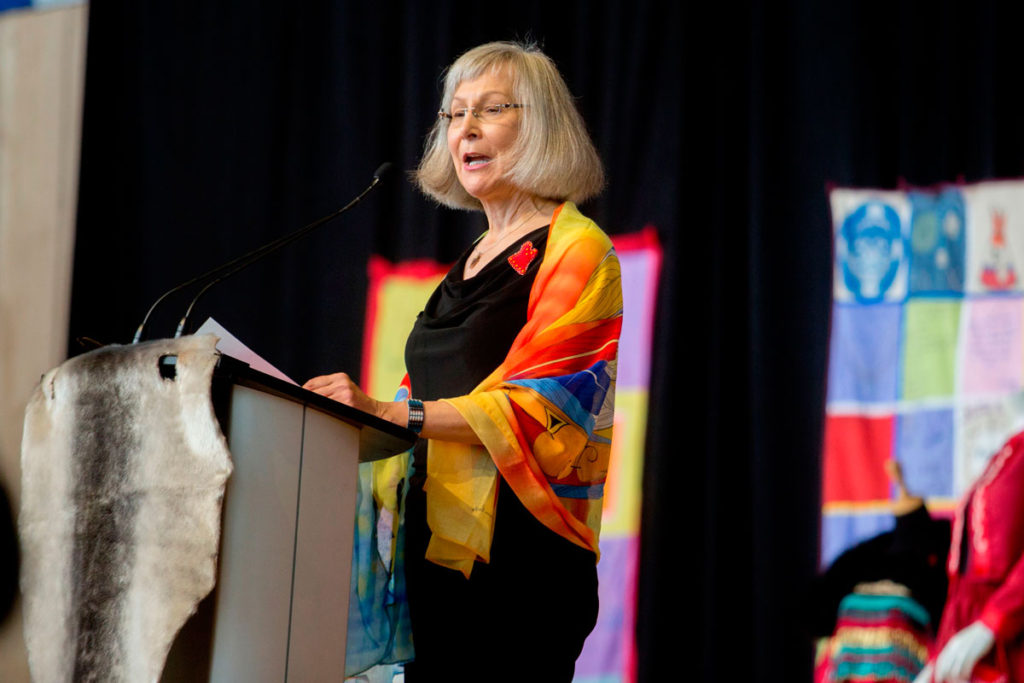News Article Article pages that do not meet specifications for other Trust Project Type of Work labels and also do not fit within the general news category.
‘This is genocide’: The final report of Canada’s inquiry into MMIWG
 At the Inquiry's closing ceremony, Chief Commissioner Marion Buller said that “an absolute paradigm shift is required to dismantle colonialism in Canadian society.”
Chief Commissioner Marion Buller speaks at the closing ceremony marking the conclusion of the National Inquiry into Missing and Murdered Indigenous Women and Girls at the Museum of History in Gatineau, Quebec on June 3, 2019. - After two and a half years of hearings, a Canadian inquiry released its final report on the disappearance and death of hundreds, if not thousands of indigenous women, victims of endemic violence it controversially said amounted to "genocide." (Photo by Andrew Meade / AFP) (Photo credit should read ANDREW MEADE/AFP/Getty Images)
At the Inquiry's closing ceremony, Chief Commissioner Marion Buller said that “an absolute paradigm shift is required to dismantle colonialism in Canadian society.”
Chief Commissioner Marion Buller speaks at the closing ceremony marking the conclusion of the National Inquiry into Missing and Murdered Indigenous Women and Girls at the Museum of History in Gatineau, Quebec on June 3, 2019. - After two and a half years of hearings, a Canadian inquiry released its final report on the disappearance and death of hundreds, if not thousands of indigenous women, victims of endemic violence it controversially said amounted to "genocide." (Photo by Andrew Meade / AFP) (Photo credit should read ANDREW MEADE/AFP/Getty Images)
The 1,200-page inquiry into missing and murdered Indigenous women and girls is firm in its calls to justice.
by ELENA SAAVEDRA BUCKLEY | High Country News
Canada’s just-released national inquiry into thousands of missing and murdered Indigenous women and girls calls the crisis “genocide.” The 1,200-page report, titled Reclaiming Power and Place, is the culmination of the National Inquiry into Missing and Murdered Indigenous Women and Girls launched in 2016 by Prime Minister Justin Trudeau. “This genocide has been empowered by colonial structures, evidenced notably by the Indian Act, the Sixties Scoop, residential schools, and breaches of human and Inuit, Métis and First Nations rights,” the report reads, “leading directly to the current increased rates of violence, death, and suicide in Indigenous populations.”

(Photo by ANDREW MEADE/AFP/Getty Images)
Trudeau, who accepted the report at the inquiry’s closing ceremony Monday at the Canadian Museum of History in Gatineau, Quebec, promised a “thorough review” and an action plan in response to the report’s 231 recommendations. The inquiry spent nearly three years holding public hearings, gathering more than 1,000 hours of testimony from 2,300 witnesses, often the families of victims and survivors. Its recommendations center on supporting Indigenous police services, overhauling current police procedures to address MMIW cases, changing criminal codes and reforming child welfare, APTN News reported.
“I was really pleased to see that the commission that had come together really explicitly stated that this is an ongoing genocide,” said Abigail Echo-Hawk, director of the Urban Indian Health Institute and chief research officer at the Seattle Indian Health Board. “To me, that was a powerful and necessary and needed statement.”
In Canada, as in the U.S., the number of missing and murdered Indigenous women and girls is disputed: The Royal Canadian Mounted Police estimated that 1,200 individuals had disappeared or been murdered since 1980, but the Native Women’s Association of Canada puts the figure for the last few decades at 4,000.
The report also focused on Indigenous people who identify as 2SLGBTQQIA, which stands for two-spirit, lesbian, gay, bisexual, transgender, queer, questioning, intersex and/or asexual. Indigenous women who align with 2SLGBTQQIA identify markers are sometimes targeted for their sexual orientation and gender identity, “creating what one researcher describes as ‘triple jeopardy’ for various forms of interpersonal and institutional violence,” the report reads.
This is not the first time the word “genocide” has been used to describe the crisis — activists and researchers like Echo-Hawk have invoked it when discussing violence toward Indigenous women and girls — but it rarely appears in government-sponsored reports. The report, as Vice noted, drew on Polish-Jewish scholar Raphael Lemkin’s definition of the term. Rather than the “immediate destruction of a nation,” Lemkin sees genocide as a more insidious force, “a coordinated plan of different actions aiming at the destruction of essential foundations of the life of national groups, with the aim of annihilating the groups themselves,” as the report quotes.
Trudeau, the Canadian press pointed out, avoided the term in his speech at the museum, instead saying that violence against Indigenous women and girls is “not a relic of Canada’s past.” But other speakers refused to let the Canadian government, and non-Indigenous citizens, off the hook. “An absolute paradigm shift is required to dismantle colonialism in Canadian society,” Marion Buller, chief commissioner of the inquiry, concluded.
Some think the report’s strong language doesn’t go far enough. “Without oversight or legally binding laws, these are just lofty words while Indigenous women and girls continue to die,” McGill University social work professor Cindy Blackstock, a member of the Gitksan First Nation and executive director of the First Nations Child and Family Caring Society of Canada, told the New York Times.
The United States, meanwhile, has no such report, nor does it have a commission for producing one — despite the fact that Native women in the U.S. are murdered at a rate 10 times higher than the national average.
“As we look at what’s happening in the U.S., I believe that that genocide didn’t stop at artificial borders between two governments,” Abigail Echo-Hawk said. “I hope that this report and its impact internationally will help elevate the conversation in the United States.”
In December 2018, the U.S. Senate held an oversight hearing on the crisis. Outgoing Sen. Heidi Heitkamp, D-N.D., who oversaw it, proposed legislation to repair the Department of Justice’s guidelines for responding to the cases of missing and murdered Indigenous women. But her bill, Savanna’s Act, had to be reintroduced this year after Rep. Bob Goodlatte, R-Va., blocked it in one of his final acts before leaving office.
The Canadian inquiry’s recommendations, framed by Indigenous-led services, human rights and trauma-informed approaches, could provide a useful example for the United States. As the report says, “It must be understood that these recommendations, which we frame as ‘Calls for Justice,’ are legal imperatives — they are not optional.”
Elena Saavedra Buckley is an editorial fellow at High Country News.
